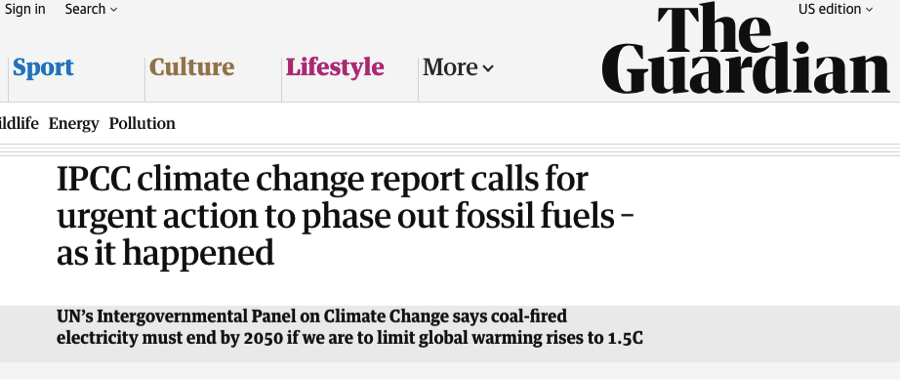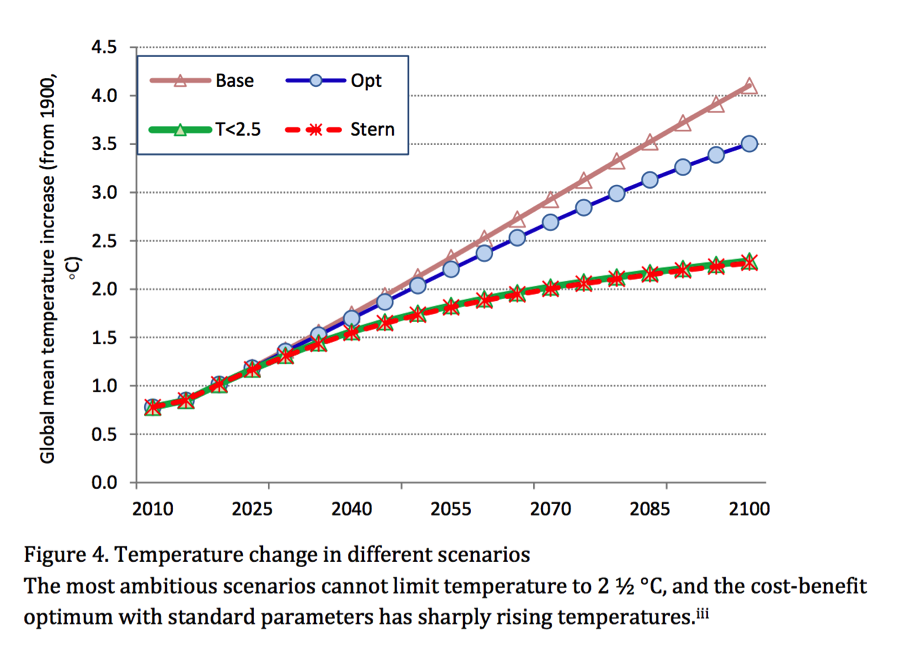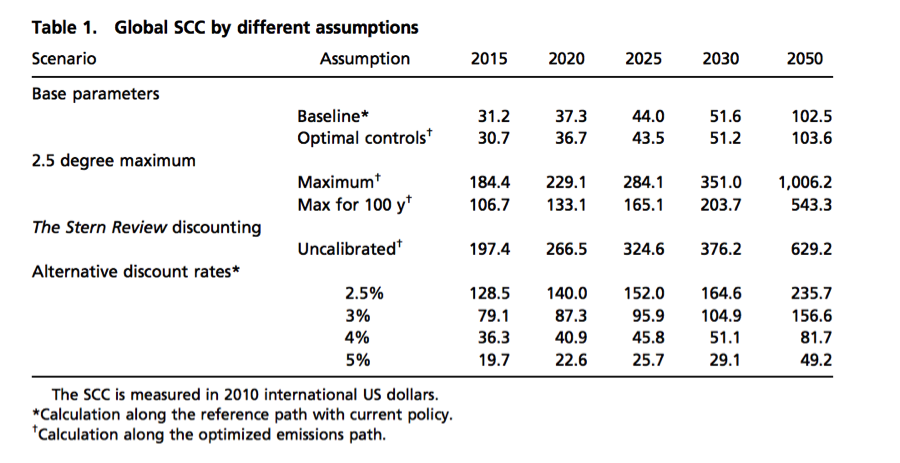In my previous IER post, I pointed out the huge contradiction in the major media treatment of climate change policy. The same day William Nordhaus shared the Nobel Prize in economics, the United Nations’s Intergovernmental Panel on Climate Change (IPCC) released its latest report. The media lauded Nordhaus and his support of a carbon tax, while it credulously repeated the IPCC calls to quickly phase out fossil fuels in order to limit warming to 1.5°C. Yet Nordhaus’ own work shows that such a policy goal is absolutely ludicrous, and in fact would make humanity much worse off than doing nothing at all about slowing climate change.
In the present article I will provide more details of just how Orwellian it is, that some pundits and reporters are linking Nordhaus with the IPCC’s latest announcement. More generally, this whole episode underscores the farce of the “social cost of carbon” (SCC) concept. The Obama Administration and academics like Nordhaus go through all of this work to generate estimates of the quantitative damage caused by carbon dioxide emissions, and then the United Nations goes ahead and recommends policies that aren’t even in the same ZIP code as what those “scientific” estimates entail. If anybody in this debate is a “denier,” it is the people claiming the IPCC’s latest pronouncements have anything to do with the peer-reviewed economics literature.
The IPCC Calls for 1.5°C
To refresh the reader’s memory, here is how The Guardian reported on the IPCC’s recent press release:

Other newspapers, blogs, and Twitter accounts used the IPCC’s announcement to tell the world what “the top scientists” were all claiming—apparently in unison. In this climate (no pun intended), the average member of the public would understandably conclude that the peer-reviewed literature weighed the pros and cons of various policies and decided that limiting global warming to 1.5°C was clearly a good thing to do. Surely the various estimates of the impact of climate change would agree that the costs of pursuing such a policy were vastly outweighed by the benefits.
I will now spend the rest of this post quoting from the most recent version of William Nordhaus’ climate modeling to show that the above claims are demonstrably false. Even though I have my differences with Nordhaus’ approach, it is surely significant that the guy who just won the Nobel Prize for his work on climate change has developed a model that shows the U.N.’s latest target is impossible and would be a cure far worse than the disease.
Nordhaus’ “Optimal” Warming
Remember that in addition to the U.N.’s recent call to limit warming to 1.5°C, there is also the Paris climate agreement, in which just about all the governments of the world—except the United States, thanks to President Trump—have agreed to limit warming to at most 2.0°C, and with the hope of keeping the ceiling lower than that.
Now in one of my most popular IER posts, I used the last IPCC documents (i.e., from the AR5) to demonstrate that this more modest ceiling of 2.0°C would likely cause more economic harm than it would spare in climate change damages.
Here I’ll do something similar. Let’s look at what Nordhaus’ most recent calibration of his DICE model said would be the “optimal” amount of warming, if all of the governments of the world implemented his preferred carbon tax at the appropriate level. The following chart comes from an NBER paper that Nordhaus updated in September 2017:

In the above figure, note that the baseline warming hits about 4.1°C by the year 2100. The “optimal” trajectory, meaning the one that would unfold with standard parameter choices if the governments of the world implemented a carbon tax exactly of the magnitude (over time) that Nordhaus recommended, would still allow for 3.5°C of warming by 2100.
Further notice in the note under the figure that in Nordhaus’ framework, the most he would even model is a 2.5°C constraint; anything less than that was so far removed the realm of possibility that it wasn’t even considered.
Estimates of the “Social Cost of Carbon”: Nordhaus vs. the U.N.
Now experts in the climate change policy debate can recognize the enormous chasm between the amount of warming that Nordhaus recommends, versus the latest target championed by the U.N. However, the lay reader might not grasp just how huge the discrepancy is.
So let’s try a different approach. In this 2017 Nordhaus paper in the Proceedings of the National Academy of Sciences (PNAS), Nordhaus again uses his most recent (2016) calibration of his DICE model to provide estimates of the “social cost of carbon” (SCC). This concept is the present value of the future net damages accruing to humanity from the emission of an extra unit (such as a metric ton) of carbon dioxide, in a particular year. It is the starting point for calibrating a tax on carbon, if the ostensible purpose is to correct the “market failure” stemming from businesses and individuals neglecting their impact on climate change.
The table below comes from Nordhaus’ PNAS paper, and it sheds light on just how outrageous the latest U.N. call really is:

In the table above, the “baseline” scenario shows what happens under business-as-usual. For example, in the year 2030, if the governments of the world haven’t taken any further action to reduce emissions and if there is no expectation that they will do so later on, then the DICE model estimates the social cost of carbon (SCC) at $51.60 per ton of carbon dioxide.
In contrast, what if governments enacted policies that would put a cap on warming at 2.5°C, so that the world couldn’t surpass that amount of warming even for a single year? (That’s the “maximum” scenario.) In order to make that a sensible outcome using a carbon tax, Nordhaus’ model says that the implied social cost of carbon in the year 2030 would be a whopping $351 per ton—roughly seven times the amount Nordhaus estimates. For those keeping score at home, a $351/ton carbon tax works out to a gasoline tax of more than $3 per gallon.
Now let’s deal with some complications: One of the reasons Nordhaus derives lower estimates for the SCC than do some other analysts, is that he uses a higher discount rate than they do, since he believes the market rate of return on capital is a more appropriate measure of the opportunity cost involved, as opposed to the analyst’s philosophical views about future generations. (I agree with Nordhaus on this point, and in any event he’s the guy who just won the Nobel for inventing the economics of climate change—so take it up with him, if you disagree.)
Having said that, even if we use the 3% discount rate that is popular in the climate change policy debate, then we still don’t get anything close to the U.N. outcome: As the table above shows, the implied SCC at a 3% discount rate in the year 2030 is “only” $104.90 per ton. Yet to remind the reader, in order to limit warming to 2.5°C, in 2030 we’d need a carbon tax of $351 per ton.
And let me emphasize: I am vastly understating the enormous disparities between Nordhaus’ estimates of the social cost of carbon—and the implied size of the “optimal” carbon tax—and what the U.N.’s latest pronouncements suggest. This is because Nordhaus only provides results for scenarios with a ceiling of 2.5°C, thinking this is the most aggressive target that is in the realm of feasibility. If instead we used the DICE model to estimate how high a carbon tax would have to be, in order to achieve the U.N.’s actual call for a ceiling of 1.5°C of warming, then of course the number would be far, far higher.
As a reminder from my previous post, when Nordhaus published the results of his 2007 analysis, at that time the 1.5°C ceiling would have made humanity $14 trillion poorer than doing nothing at all about climate change. (See Table 4 of my 2009 article on Nordhaus.)
Conclusion
Those of us who are skeptical of the case for a carbon tax have been accused of all sorts of skullduggery, including “science denial.” Yet as the recent media handling of William Nordhaus’ Nobel award and the U.N.’s latest IPCC report reveal, it is the boosters of aggressive government action who ignore the peer-reviewed research. Both the Obama Administration Working Group and the latest calibration of Nobel laureate Nordhaus’ model estimate that the “social cost of carbon” is nowhere near the level it would need to be, to justify the U.N.’s call to limit warming to 1.5°C.
The whole episode shows the farce of this alleged scientific and empirical process. After going through the trouble of estimating the SCC, the interventionist camp then proceeds to trumpet policy goals that utterly ignore their own results.



